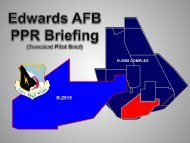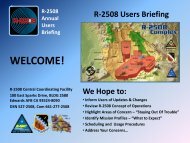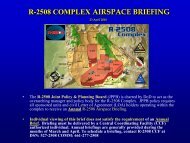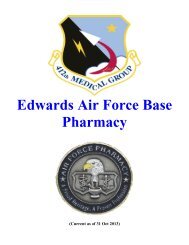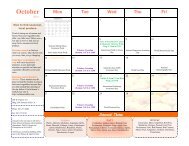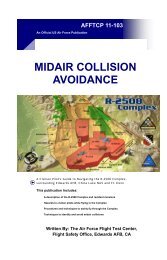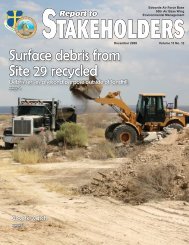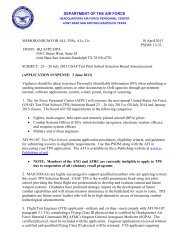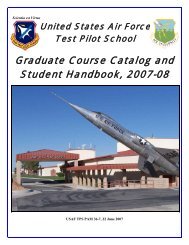AF Plant 42 AICUZ Study - Feb. 2012 - Edwards Air Force Base
AF Plant 42 AICUZ Study - Feb. 2012 - Edwards Air Force Base
AF Plant 42 AICUZ Study - Feb. 2012 - Edwards Air Force Base
You also want an ePaper? Increase the reach of your titles
YUMPU automatically turns print PDFs into web optimized ePapers that Google loves.
Land use guidelines for <strong>Air</strong> <strong>Force</strong> <strong>AICUZ</strong> outlined in <strong>Air</strong> <strong>Force</strong><br />
Handbook (<strong>AF</strong>H) 32-7084 <strong>AICUZ</strong> Program Manager’s Guide<br />
reflect preferred land use recommendations for areas underlying<br />
clear zones (CZs), accident potential zones (APZs) I and II, as well<br />
as for four predicted noise exposure zones (a description of these<br />
areas can be found in Chapter 3):<br />
<br />
<br />
<br />
<br />
65-70 A-weighted decibel (dB[A]) day-night average sound<br />
level (DNL);<br />
70-75 dB(A) DNL;<br />
75-80 dB(A) DNL; and<br />
80+ dB(A) DNL.<br />
The predicted noise exposure zones are delineated by connecting<br />
points of equal noise exposure (contours). Land use<br />
recommendations for these noise exposure zones have been<br />
established on the basis of sociological studies prepared and<br />
sponsored by several federal agencies, including the U.S.<br />
Department of Housing and Urban Development (HUD), the U.S.<br />
Environmental Protection Agency (EPA), the U.S. Department of<br />
Transportation (DoT), and the <strong>Air</strong> <strong>Force</strong>, as well as state and local<br />
agencies. The guidelines recommend land uses that are compatible<br />
with airfield operations while allowing maximum beneficial use of<br />
adjacent properties. Additionally, guidelines for maximum height<br />
of man-made structures are provided to protect the navigable<br />
airspace around an airfield, particularly the approach/departure<br />
corridors extending along the axis of the runways. The <strong>Air</strong> <strong>Force</strong><br />
has no desire to recommend land use regulations that would render<br />
property economically useless. The <strong>Air</strong> <strong>Force</strong> does, however, have<br />
an obligation to the inhabitants of the <strong>Plant</strong> <strong>42</strong> environs and to the<br />
citizens of the United States to point out ways to protect the people<br />
in adjacent areas as well as the public investment in the installation<br />
itself.<br />
The <strong>AICUZ</strong> program uses the latest technology to define noise<br />
levels in areas near <strong>Air</strong> <strong>Force</strong> installations. An analysis of <strong>Plant</strong><br />
<strong>42</strong>'s existing and anticipated flying operations was performed,<br />
including types of aircraft, flight patterns, variations in altitude,<br />
power settings, number of operations, and hours of operations. This<br />
information was used to develop the noise contours contained in<br />
this study. The DoD NOISEMAP modeling software and the<br />
previously mentioned DNL metrics were used to define the noise<br />
exposure zones at <strong>Plant</strong> <strong>42</strong>. In addition and in recognition of<br />
California’s use of a similar but alternative noise metric,<br />
1-3



